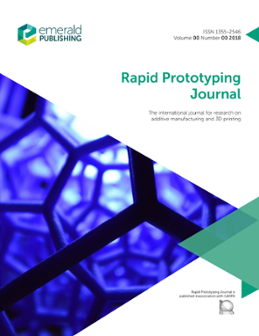Rapid Prototyping Journal: Volume 26 Issue 1
Strapline:
The international journal for research on additive manufacturing and 3D printingTable of contents
Perfusive and osmotic capabilities of 3D printed hollow tube for fabricating large-scaled muscle scaffold
Qin Lian, Linian Zhou, Xiao Li, Wei Mao, Dichen LiThe purpose of this paper is to present a new method for the fabrication of a large-scaled muscle scaffold containing an artificial hollow tube network, which may solve the…
Experimental study on leveling mechanism for material-jetting-type color 3D printing
Yih-Lin Cheng, Chih-Hsuan Chang, Chunliang KuoThe material-jetting-type (MJ) 3-D printing technology has advantages in resolution and color printing. During the printing process, a leveling technique is needed to precisely…
Open hole tensile testing of 3D printed parts using in-house fabricated PLA filament
Harshit K. Dave, Ashish R. Prajapati, Shilpesh R. Rajpurohit, Naushil H. Patadiya, Harit K. RavalFused deposition modeling (FDM) is being increasingly used in automotive and aerospace industries because of its ability to produce specimens having difficult geometrical shape…
Antibacterial silver submicron wire-polylactic acid composites for fused filament fabrication
Jenna Stephanie Walker, John Arnold, Cynthiya Shrestha, Damon SmithThe purpose of this study is to explore the use of silver submicron-scale wire (AgSMW) additives in filament feedstock for fused filament fabrication (FFF) additive manufacturing…
Effect of clay functionally graded materials on dual gradient direct ink writing behavior and microstructure of geological model
Danna Tang, Liang Hao, Yan Li, Zheng LiThe study aims to explore the composition and microstructure of clay functionally graded materials under the process of double-gradient direct ink writing (DIW).
Cylindrical slicing and path planning of propeller in wire and arc additive manufacturing
Rui Wang, Haiou Zhang, Wang Gui-Lan, Xushan ZhaoThe wire and arc additive manufacturing (WAAM) is a promising technology, but the parts are mostly manufactured on the plane and along the vertical direction. The purpose of this…
3D printing build orientation optimization for flexible support platform
Hongyao Shen, Xiaoxiang Ye, Guanhua Xu, Linchu Zhang, Jun Qian, Jianzhong FuDuring the 3D printing process, the model needs to add a support structure to ensure structural stability. Excessive support structure reduces printing efficiency and results in…
Correlation between porosity and permeability of stainless steel filters with gradient porosity produced by SLS/SLM
Aloysio Arthur Becker Fogliatto, Carlos Henrique Ahrens, Paulo Antônio Pereira Wendhausen, Edson Costa Santos, Daniel RodriguesPorous structures have been widely used in filtration, medical implants and aerospace field. In the filtration field, the study of permeability of the porous structures is of…
Network-based pricing for 3D printing services in two-sided manufacturing-as-a-service marketplace
Deepak Pahwa, Binil StarlyThis paper presents approaches to determine a network-based pricing for 3D printing services in the context of a two-sided manufacturing-as-a-service marketplace. The purpose of…
Additive manufacturing infill optimization for automotive 3D-printed ABS components
Matt Schmitt, Raj Mattias Mehta, Il Yong KimLightweighting of components in the automotive industry is a prevailing trend influenced by both consumer demand and government regulations. As the viability of additively…
Camera signal dependencies within coaxial melt pool monitoring in laser powder bed fusion
Tobias Kolb, Reza Elahi, Jan Seeger, Mathews Soris, Christian Scheitler, Oliver Hentschel, Jan Tremel, Michael SchmidtThe purpose of this paper is to analyse the signal dependency of the camera-based coaxial monitoring system QMMeltpool 3D (Concept Laser GmbH, Lichtenfels, Germany) for laser…
Increasing strength of FFF three-dimensional printed parts by influencing on temperature-related parameters of the process
Vladimir E. Kuznetsov, Alexey N. Solonin, Azamat Tavitov, Oleg Urzhumtsev, Anna VakulikThis paper aims to investigate how the user-controlled parameters of the fused filament fabrication three-dimensional printing process define temperature conditions on the…
Thermal cycling, microstructure and tensile performance of PLA-PHA polymer printed using fused deposition modelling technique
Sofiane Guessasma, Sofiane Belhabib, Hedi NouriThis paper aims to investigate the effect of printing temperature on the thermal and the mechanical behaviour of polylactic acid (PLA)-polyhydroxyalkanoate (PHA) blend printed…
Fast production of customized three-dimensional-printed hand splints
Diana Popescu, Aurelian Zapciu, Cristian Tarba, Dan LaptoiuThis paper aims to propose a new solution for producing customized three-dimensional (3D)-printed flat-shaped splints, which are then thermoformed to fit the patient’s hand. The…
Additive manufacturing by material extrusion with medical grade silicone elastomers and IR laser curing
Daniel A. Porter, Nicholas Davis, Paul S. Krueger, Adam L. Cohen, David SonTechniques of extrude and cure additive manufacturing for thermally cured, high viscosity and medical-grade silicone are investigated by using a small ram extruder and a…
Polyvinylidene fluoride (PVDF) as a feedstock for material extrusion additive manufacturing
Niknam Momenzadeh, Hadi Miyanaji, Daniel Allen Porter, Thomas Austin BerfieldThis study aims to investigate the material extrusion additive manufacturing (MEAM) deposition parameters for creating viable 3-D printed polyvinylidene fluoride (PVDF) structures…
Slicing heterogeneous solid using octree-based subdivision and trivariate T-splines for additive manufacturing
Bin Li, Jianzhong Fu, Yongjie Jessica Zhang, Weiyi Lin, Jiawei Feng, Ce ShangMajority of the existing direct slicing methods have generated precise slicing contours from different surface representations, they do not carry any interior information…
Fused deposition modelling: a review
Swapnil Vyavahare, Soham Teraiya, Deepak Panghal, Shailendra KumarFused deposition modelling (FDM) is the most economical additive manufacturing technique. The purpose of this paper is to describe a detailed review of this technique. Total 211…
Improving the forming quality of fused filament fabrication parts by applied vibration
Shijie Jiang, Yannick Siyajeu, Yinfang Shi, Shengbo Zhu, He LiThe purpose of this study is to investigate the efficiency of applied vibration in improving the forming quality (mechanical property and dynamics characteristics) of fused…
Influence of thermal properties on residual stresses in SLM of aerospace alloys
Mostafa Yakout, M.A. Elbestawi, S.C. Veldhuis, S. Nangle-SmithResidual stresses are induced during selective laser melting (SLM) because of rapid melting, solidification and build plate removal. This paper aims to examine the thermal cycle…

ISSN:
1355-2546Online date, start – end:
1995Copyright Holder:
Emerald Publishing LimitedOpen Access:
hybridEditor:
- Professor Ian Gibson